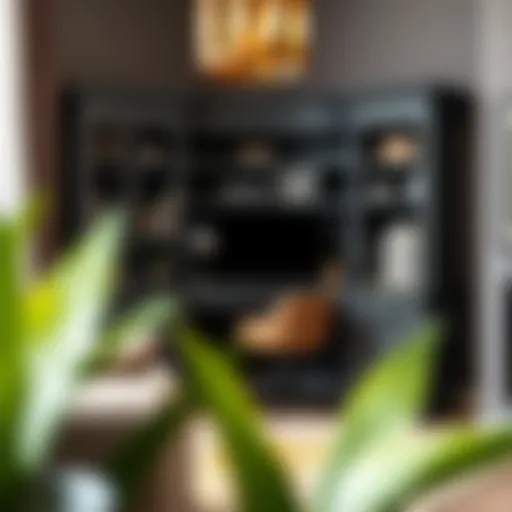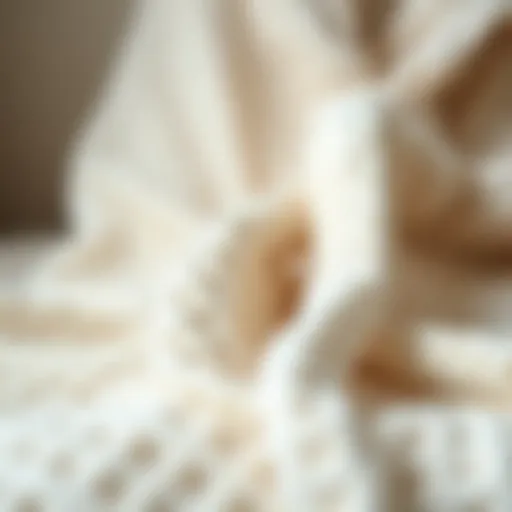Bamboo Shades: An Insight into Top-Down and Bottom-Up
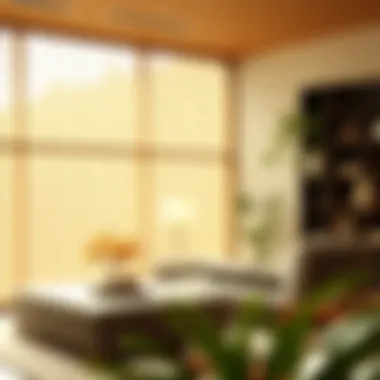

Intro
Bamboo shades, with their unique charm, are more than just window treatments; they elegantly merge nature with function. Whether it’s the soft warmth that natural materials bring or their tailored functionality, these shades can transform a living space into something remarkable.
As homeowners, designers, and retailers begin to grasp these intricacies, the multifaceted nature of bamboo shades, particularly top-down and bottom-up mechanisms, emerges as a game changer in interior design. Understanding how these features work provides a pathway to achieving not only visual appeal but also practicality in everyday use.
In the upcoming sections, we will peel back the layers on the benefits of these shades, installation techniques, design implications, and key factors influencing choices.
Let’s delve deeper into how current design trends integrate with bamboo shades, enriching our interiors and enhancing individual expression.
Prolusion to Bamboo Shades
Bamboo shades are gaining traction as an elegant option for window treatments, blending functionality with an organic feel. Their significance in home decor is not just in looks; they deliver practical benefits, making them worthy of exploration in any interior design strategy. Bamboo shades can transform a room, influencing ambiance, light regulation, and privacy management.
Choosing the right window treatment goes beyond just aesthetics. It's about finding a balance between style and function. In this context, bamboo shades offer something unique. The natural materials and versatile designs make them suitable for various settings, from minimalist spaces to bohemian interiors. With an increasing number of homeowners looking to incorporate sustainable practices, these shades also align with eco-friendly preferences.
In this section, we’ll dive into the specifics:
- The definition and material composition of bamboo shades.
- A glimpse into their historical context, revealing how they’ve become popular over time.
With the right information, discerning homeowners, designers, and DIY enthusiasts can make informed decisions about incorporating bamboo shades into their spaces.
Types of Bamboo Shades
Understanding the different types of bamboo shades is essential for anyone considering them as a window treatment option. Each type offers distinct features, benefits, and considerations that align with various design aesthetics and functional requirements. Knowing the nuances between natural and synthetic materials, as well as the variety of weave patterns available, can significantly influence a homeowner’s or designer's decision-making process. It’s not solely about appearance; the practicality of each shade type plays a crucial role in how effective they will be in managing light and privacy, as well as their overall durability.
Natural vs. Synthetic Bamboo Materials
When it comes to bamboo shades, the material choice—natural versus synthetic—can have a profound impact on both functionality and style.
Natural bamboo materials are often favored for their organic feel and sustainability. Crafted from real bamboo, these shades showcase the unique textures of the wood, providing an earthy aesthetic that brings an outdoor vibe inside. Homeowners appreciate the timeless quality that natural bamboo brings. Furthermore, they are an eco-friendly option, appealing to those conscious about their carbon footprint. However, natural bamboo shades may require more maintenance as they can be susceptible to moisture and insect damage over time.
On the other hand, synthetic bamboo materials, commonly made from man-made fibers that imitate the look of bamboo, offer their own distinct advantages. One of the highlights of synthetic shades is their enhanced durability. They tend to be more resistant to wear and tear, moisture, and fading, making them ideal for areas with higher humidity—think kitchens and bathrooms. They also come in a wider array of colors and patterns, catering to diverse decorating styles. However, the overall charm of synthetic options may fall short compared to their natural counterparts.
"Opting for the right material involves weighing aesthetics against practicality; it's about finding the balance that suits your environment."
Various Weave Patterns
Moving beyond materials, the weave patterns of bamboo shades further enrich their versatility in interior design. The pattern not only influences the style quotient but also how light enters a space.
- Horizontal Weaves: This type offers a classic look and is particularly effective for light control and privacy. Horizontal weaves allow for ease in raising and lowering the shades while offering an elegant view when partially opened.
- Vertical Weaves: Vertical patterns can introduce an element of dramatic flair to a room. These tend to elongate the visual perception of windows, often making ceilings appear taller.
- Textured Weaves: Shades with a textured pattern can add depth and interest to an interior space. A more intricate weave may also diffuse light differently, casting unique shadows throughout the day.
- Solid Weaves: Advantages of solid-patterned bamboo shades include their simplicity and elegance. They provide a clean look that works well with minimalist interior designs.
Ultimately, the choice of weave pattern should reflect the desired ambiance within the space. Consider factors such as existing decor, desired light levels, and how much privacy is needed in each room.
In summary, exploring natural vs. synthetic materials and various weave patterns is crucial in selecting bamboo shades that not only enhance the decor but also meet practical needs. This understanding serves as a foundation for the later sections discussing mechanisms and operational benefits.


Top-Down Bamboo Shades
Top-down bamboo shades are a remarkable innovation that seamlessly blend style with functionality. Their distinctive operation is key for modern homeowners seeking versatility in how they manage light and privacy. Unlike traditional shades, which only move from the bottom up, top-down shades offer a refreshing alternative that allows users to draw the fabric down from the top of the window. This capability makes them incredibly valuable in spaces like living rooms and bedrooms where light control and maintaining privacy are paramount.
The range of benefits associated with top-down bamboo shades adds to their appeal. They cater to various design preferences while enhancing a room's aesthetic at the same time. But how do they work, and what are the specific advantages? Let’s delve deeper to uncover the mechanism and distinct perks of these window treatments.
Bottom-Up Bamboo Shades
Bottom-up bamboo shades, a distinct approach to window treatments, provide a blend of functionality and design appeal. They are particularly useful for those seeking more control over natural light and privacy without sacrificing aesthetics. This section delves into how these shades operate and the array of advantages they bring to the table, alongside considerations that homeowners and designers should keep in mind.
Mechanism of Operation
The mechanism behind bottom-up bamboo shades is relatively straightforward yet effective. Designed to be raised from the bottom of the window upward, these shades allow the user to adjust their position to control light levels. When you're seeking to maximize sunlight, simply draw the shade up, and when you need to shield your space, let it down as desired. This flexible operation is ideal for varying daylight conditions and different times of the day.
Moreover, these shades often come equipped with options for corded or cordless mechanisms, with the latter being a safer choice for homes with small children or pets, reflecting a modern approach to both convenience and safety.
Advantages of Bottom-Up Functionality
Ground-Up Light Management
Bottom-up shades excel in ground-up light management, allowing users to tailor the influx of sunlight based on their immediate needs. This characteristic empowers homeowners with increased flexibility. For instance, if you want to flood your living room with light while still maintaining privacy from neighbors, you can lower the shade partially. The ability to control incoming sunlight without completely blocking your vistas is a considerable advantage.
Furthermore, many find bamboo shades add a warm tone to interior spaces, enhancing overall ambiance—something typical blinds might lack. The natural textures lend character, breathing life into a room. However, one must consider the fact that not all designs are made equal; some fabrics may not offer comprehensive UV protection, making it necessary to choose wisely.
Combination with Other Window Treatments
The versatility of bottom-up shades allows them to easily combine with other window treatments, amplifying their effectiveness. Many designers recommend using them alongside sheer curtains or drapes for a layered effect. This combination not only enriches the visual texture of your windows but also offers improved light control.
Layering treatments can create a cocooning effect, enhancing insulation and sound absorption. However, it is crucial to balance competing aesthetics; if one layer overshadows the other, the overall decor may fall flat. Striking this balance ensures a cohesive visual language throughout your space.
Versatility in Space Design
Bamboo shades' versatility extends to their adaptability in various design schemes. Whether you’re working with a minimalistic approach, a rustic theme, or something in between, these shades enhance the overall look of a room. Their natural finish blends harmoniously with wood accents, stone elements, or even sleek metal features.
What sets bamboo shades apart is their myriad of finishes—both natural and stained options. This means they can cater to the whims of your personal style without compromising on functionality. The downside to this versatility is selecting the right match for your decor can feel overwhelming due to the myriad of options available.
Installation Considerations
When considering bottom-up bamboo shades, installation is a key discussion point. Proper measurement of window frames cannot be overstated. The shades must fit snugly to function effectively, allowing for optimal privacy and light control. You have the option for inside or outside mount, with each having its advantages and disadvantages regarding aesthetics and light coverage.
Additionally, if you're not particularly handy with tools, hiring a professional could save time and ensure a more polished look. But, for those who enjoy DIY projects, installing these shades can be a rewarding endeavor that not only enhances your space but boosts sense of accomplishment as well.
Comparative Analysis: Top-Down vs Bottom-Up
When considering bamboo shades, the choice between top-down and bottom-up mechanisms is far from trivial. Each system provides distinct advantages tailored to different needs and preferences. By diving into this comparative analysis, we will explore several facets: functionality and use cases, aesthetic appeal, and cost considerations that may sway a homeowner’s or designer's decision.
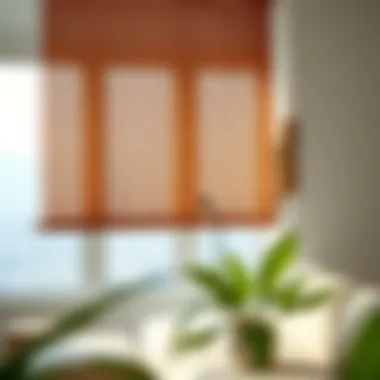

Functionality and Use Cases
Both top-down and bottom-up shades boast alluring functionalities, but they cater to various scenarios.
Top-down bamboo shades allow you to lower the top while keeping the bottom part secured. This feature is invaluable in spaces like a cozy nook or a bedroom, where maintaining natural light while ensuring privacy ranks high. Alternatively, the bottom-up function offers versatility mainly in living areas, where users might want to regulate sunlight exposure from the bottom without compromising too much on privacy.
- Top-Down Benefits:
- Bottom-Up Benefits:
- Greater control over light entering the room
- Ideal for layered window treatments
- Enhances privacy while allowing light to filter in from above
- Easy transition from window sill to ceiling
- Seamlessly integrates with existing décor
- Provides a grounded approach to light management
Aesthetic Appeal
The visual allure of bamboo shades cannot be overstated. They inherently exude warmth and sophistication, invigorating both modern and traditional interiors.
In the context of aesthetics, top-down shades can create a unique dynamic, enabling light to cascade into the room from above while maintaining a closed environment down low. This setting might be particularly picturesque in open spaces with a rustic twist.
On the other hand, bottom-up shades transform the ambiance depending on how much they’re pulled up or down. Letting light filter through the bottom adds a touch of design flexibility that can harmonize with various styles, from minimalist zen to bohemian chic.
Visual features to consider:
- Colors and patterns of the bamboo weave
- Effect on room illumination
- Compatibility with existing décor
Cost Considerations
It's no secret that budgeting plays a central role in any home improvement project, including the choice of window treatments. While both top-down and bottom-up shades typically fall within a similar price range, there can be variations based on customization, materials used, and additional features.
Additionally, components involved in each mechanism can influence the overall cost:
- Top-down versions might carry slightly higher pricing due to their intricate hardware and adjustment systems. However, investing here often pays dividends in functionality and light control.
- Bottom-up shades may sometimes be more affordable, particularly if they come in standard sizes without tailored options. Nonetheless, the beauty and practicality offered with both styles may be worth every penny.
In summary, the choice between top-down and bottom-up bamboo shades encompasses more than preference. Lighting, aesthetic consideration, and costs play pivotal roles in guiding a decision. It's crucial to weigh these aspects carefully to achieve not just beauty, but also functionality, in any space.
Factors Influencing Choice
When it comes to selecting bamboo shades, various factors come to play that will guide homeowners and designers in making the best decision. Understanding these elements can greatly influence aesthetics, functionality, and the overall feel of a space. With the rise of eco-conscious design, the decision-making process becomes more layered, taking into account practical needs and personal beliefs regarding sustainability. Let’s break down three primary considerations that can help pinpoint the right kind of bamboo shades for any setting.
Space and Lighting Conditions
In pondering bamboo shades, one must first consider the specific lighting conditions of the space. Natural light can behave differently based on the room’s orientation and window size. For sunnier rooms, top-down shades often offer a practical solution, allowing light to flow in while still maintaining privacy. Conversely, bottom-up shades may suit spaces that require more direct control over bright light, allowing homeowners to tailor their shading needs according to the particular time of day.
The texture and weave pattern of bamboo shades can also affect light penetration. For instance, a tightly woven shade may give more privacy at night, while looser weaves could create a more diffused light quality. Homeowners should take a moment to observe how the sun dances through their window throughout the day and select shades that enhance that experience without compromising comfort.
Personal Preference and Style
Style is not just a personal expression but a reflection of one’s lifestyle and values. Bamboo shades offer a spectrum of aesthetics, from rustic charm to sleek modernity. Individuals drawn toward a natural, earthy vibe might lean toward natural bamboo fibers that retain their original tone and texture. On the other hand, someone with a contemporary aesthetic might opt for painted or stained shades that align with their color palette.
The versatility of these shades allows them to blend seamlessly with various design elements, such as casual or formal decor. Customization options are plentiful, making it easier for homeowners to find shades that suit their unique taste while remaining functional.
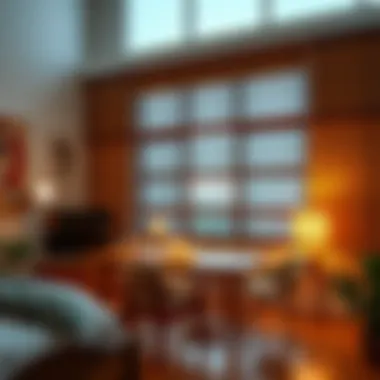

Consideration should also be given to the existing furnishings and color schemes. Selecting shades that harmonize with your overall space can enhance the cohesiveness of the design. Installations such as layered treatments, combining bamboo shades with drapes or curtains, can further the depth of a room’s aesthetics.
Environmental and Sustainability Considerations
Today, sustainability often tops the list for many discerning consumers. Bamboo is known for being one of the fastest-growing plants in the world, and its use in window treatments is an environmentally friendly option. Choosing bamboo shades not only serves a functional purpose but also aligns with a commitment to eco-friendly materials.
Beyond the material itself, it’s crucial to consider where the bamboo is sourced from. Products made from sustainably harvested bamboo demonstrate a respect for the environment and support for responsible forestry practices.
Furthermore, many manufacturers now employ fair-trade practices, ensuring ethical labor standards. Therefore, making an informed choice about bamboo shades goes beyond mere aesthetics; it's also an opportunity to support sustainable initiatives.
"Choosing bamboo shades is not just about style; it’s a step towards a more sustainable living experience."
In sum, the choice of bamboo shades hinges on a multitude of factors including light dynamics, personal taste, and a commitment to the environment. Taking these elements into account allows for a selection that resonates with your lifestyle while contributing positively to the space and the world.
Maintenance of Bamboo Shades
Maintaining bamboo shades is crucial for their longevity and continued aesthetic appeal. Crafted from natural materials, these window treatments breathe a certain charm into interior spaces, but they also require diligent care. Neglecting them could lead to wear and tear that detracts from their beauty and functionality. A few simple routines can make all the difference, ensuring these shades remain vibrant and effective over time.
Cleaning Techniques
Regular cleaning is vital for bamboo shades, given that dust and grime can accumulate and dull their luster. Keeping them clean not only enhances appearance but can also prevent long-term damage. Here are some effective cleaning techniques:
- Dusting: Use a soft cloth or a microfiber duster to wipe down the shades. This can be done weekly or every other week, depending on the dust levels in your area.
- Vacuuming: If the shades require a deeper clean, a vacuum with a brush attachment can be helpful. Gently run the brush along the surface to pick up dirt without damaging the bamboo.
- Spot Cleaning: In case of stains, use a damp cloth with a mild cleaner. Ensure to wipe gently to avoid damaging the finish of the bamboo.
- Deep Cleaning: For a thorough clean, remove the shades from the window, if possible. Submerge them in warm water mixed with a gentle soap, then rinse gently before rehanging.
"Regular maintenance turns ordinary into extraordinary; this is especially true for sophisticated products like bamboo shades."
Long-Term Care Tips
Caring for bamboo shades requires attention not just to cleaning, but also to their environment and usage. Here are some long-term care tips that can help retain their charm for years:
- Mind the Sun: Prolonged exposure to direct sunlight can fade the color and weaken the fibers. Consider closing the shades during peak sunlight hours or using UV protective window films.
- Humidity Control: Since bamboo is a natural material, excessive humidity can lead to warping or mold. Ensure that the installation location does not have high moisture levels, and use a dehumidifier if needed.
- Avoid Excessive Weight: When pulling down or lifting shades, do so gently. Avoid putting any excess weight on the shades, as they are not designed to carry heavy loads.
- Inspect Regularly: Periodically check for any signs of wear and tear, such as loose cords or frayed edges. Addressing these issues early can prevent more significant problems down the line.
Regular attention to cleaning and maintenance will keep bamboo shades looking fresh and functional, enhancing the overall aesthetic appeal of your space for many years to come. For more insights on caring for natural materials, visit Wikipedia, or explore further practical tips from home improvement sites such as This Old House.
Finale
Bamboo shades serve not only as decorative elements but also fulfill practical needs for any space. In this article, we’ve delved into the inner workings and advantages of both top-down and bottom-up mechanisms. It’s essential to note that understanding these treatments goes beyond mere aesthetics; the functionality they offer can significantly enhance the comfort and ambiance of a room.
Summarizing Key Insights
Reflecting on what we've covered, bamboo shades offer unique features that cater to various design philosophies and practical requirements. The ability to manage light and privacy with precision makes these shades highly adaptable. Here are a few critical points that summarize our discussion:
- Flexibility in Light Control: Top-down and bottom-up mechanisms allow users to fine-tune the amount of light entering a room, thus reducing glare while maintaining outside views.
- Design Integration: They merge seamlessly with various decor styles, from minimalist to bohemian, ensuring that every aesthetic can be enhanced by the natural textures of bamboo.
- Sustainability: With increasing emphasis on eco-friendly living, bamboo shades present an attractive solution, utilizing renewable materials that carry less environmental impact than traditional window coverings.
These attributes highlight how bamboo shades can elevate both functionality and aesthetics in interior design, appealing to homeowners, designers, and industry experts alike.
Encouragement for Thoughtful Selection
When choosing bamboo shades, it’s vital to consider personal preferences alongside practical needs. A thoughtful selection process will not only yield better results for the environment but also for your living or working space.
- Reflect on Lifestyle: Assess your daily habits and usage of natural light. Do you enjoy bright spaces, or do you prefer soft, filtered light?
- Match with Overall Design: Ensure that the style, weave, and color of the bamboo shades complement your existing decor. This cohesion can greatly enhance room aesthetics.
- Seek Professional Advice: If unsure, consulting with interior design professionals can guide you to make an informed choice that balances beauty with practicality.
Ultimately, a well-considered decision on bamboo shades contributes to not only a beautiful room but also an efficient one. For more insights into the benefits and styles, check out resources like Wikipedia, Britannica, and design forums on Reddit.









